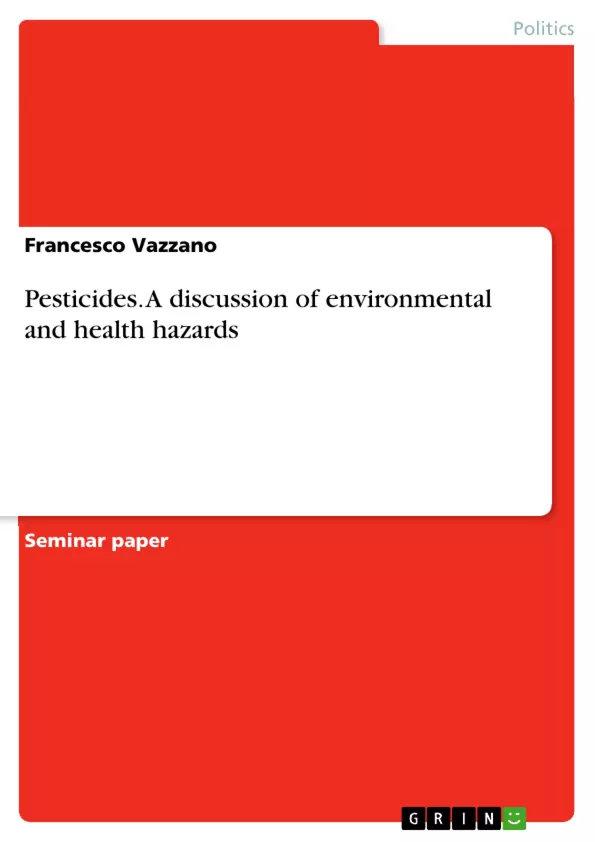"Of course it is possible, in some places even to increase with the use of pesticides, the yield of intensive agriculture. But it is wrong to conclude that this intensification is worth per se. Because the victims of pesticide use and the costs that are imposed on the public will forget."
Rudolf Susanne. 01.04.2012. Pestizide: Vom Schaden der Schädlingsbekämpfung. Ropress Genossenschaft Zürich
I start with this citation, because these thoughts reflect at large my personal opinion about pesticides. The use and hazards of pesticides are not a main issue in the news, even though they are a problem and danger of our life and our environment.
I will continue with a discussion of environmental and health hazards. After that I will analyze the roles and strategies of different influential groups. I will conclude this work suggesting ethical principles to manage these risks.
Inhaltsverzeichnis (Table of Contents)
- Introduction
- Health hazards
- Poisoning
- Chronic diseases
- Environmental hazards
- Persistent organic pollutants (POPs)
- Fruit and vegetables
- Environmental degradation
- Production and storage
- Different roles and strategies
- The Government
- The Industry
- User and Retail
- Consumers
- Non-Governmental Organizations
- Ethical principles
- Bibliography
Zielsetzung und Themenschwerpunkte (Objectives and Key Themes)
This work explores the multifaceted issue of pesticides, focusing on their environmental and health hazards. It examines the role of various stakeholders, including governments, industry, and consumers, in managing the risks associated with pesticide use. The work concludes by proposing ethical principles for addressing these challenges.- Health risks posed by pesticides, including poisoning and chronic diseases
- Environmental impacts of pesticides, encompassing pollution, biodiversity loss, and degradation
- Diverse roles and strategies of stakeholders in pesticide management
- Ethical considerations and principles for responsible pesticide use
- The need for comprehensive and integrated approaches to address pesticide-related risks
Zusammenfassung der Kapitel (Chapter Summaries)
- Introduction: This chapter introduces the topic of pesticides, highlighting the controversial nature of their use and the potential consequences for both human health and the environment. The author emphasizes the need for a broader understanding of the risks associated with pesticides, beyond their perceived benefits.
- Health hazards: This chapter examines the health risks posed by pesticides, focusing on two key aspects: poisoning and chronic diseases. It explores the global burden of pesticide poisoning, particularly among agricultural workers, and discusses the challenges associated with establishing a clear link between pesticide exposure and specific chronic diseases.
- Environmental hazards: This chapter delves into the environmental hazards posed by pesticides, covering a range of issues including persistent organic pollutants, contamination of food sources, and environmental degradation. It highlights the importance of considering the long-term consequences of pesticide use, particularly in terms of ecosystem health and biodiversity.
- Different roles and strategies: This chapter examines the roles and strategies of various stakeholders in managing the risks associated with pesticide use. It analyzes the responsibilities of governments, industry, users, consumers, and non-governmental organizations, highlighting the need for collaboration and coordination in implementing effective policies and practices.
Schlüsselwörter (Keywords)
This work focuses on the multifaceted issue of pesticides, exploring their impact on human health and the environment. Key themes include pesticide poisoning, chronic diseases, environmental pollution, stakeholder responsibilities, ethical considerations, and the need for sustainable and responsible practices in agriculture and pesticide management.- Quote paper
- Francesco Vazzano (Author), 2013, Pesticides. A discussion of environmental and health hazards, Munich, GRIN Verlag, https://www.grin.com/document/232850



